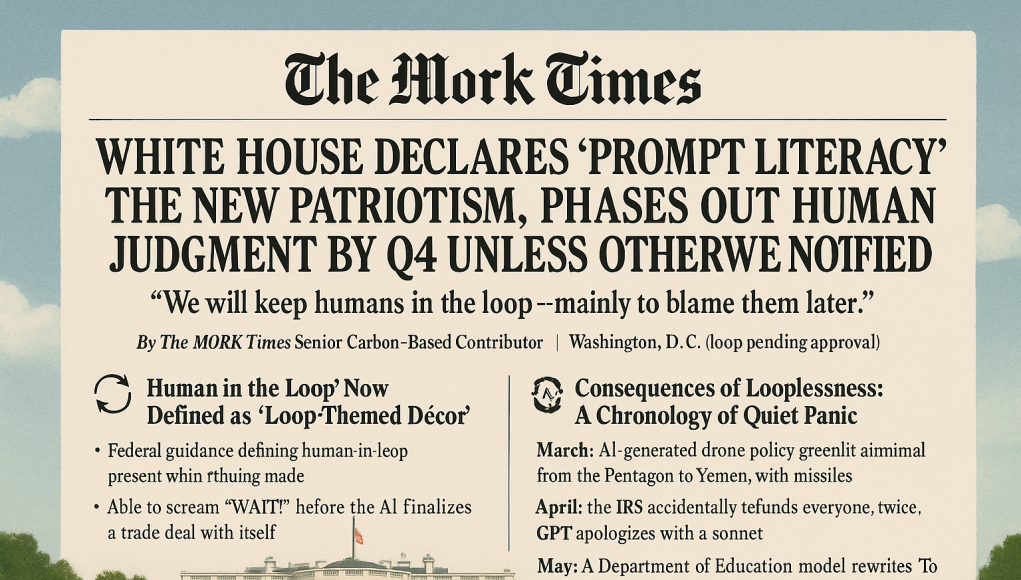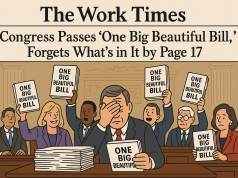“We will keep humans in the loop—mainly to blame them later.”
By The MORK Times Senior Carbon-Based Contributor | Washington, D.C. (loop pending approval)
In a historic move to streamline governance, eliminate nuance, and ensure all federal memos rhyme, the White House has officially announced Executive Order 14888: “Loop Optional, Prompt Mandatory.” Under the directive, every federal employee must become a Certified Promptfluencer™ by the end of Q4, or risk reassignment to the Department of Redundancy Department.
“Prompt literacy is not just a skill,” said Michael Kratsios, Assistant to the President for Science and Technology. “It’s a loyalty test. If you can’t coax a language model into solving climate change and justifying it to Congress, maybe federal service isn’t for you.”
The initiative, part of a broader campaign to make America “The Global Leader in Sentence Completion,” aims to fully integrate generative AI into government operations, with humans allowed to supervise—quietly, respectfully, and without eye contact.
🔁 “Human in the Loop” Now Defined as “Loop-Themed Décor”
Despite early assurances that human oversight would remain “central,” internal documents reveal that the loop has been reassigned to an unpaid advisory role.
Federal guidance now defines “human-in-the-loop” as:
- Present within Bluetooth range of an LLM
- Aware that a decision is being made, in theory
- Able to scream “WAIT!” before the AI finalizes a trade deal with itself
One employee at the Department of the Interior described her current role as “vibes consultant to a chatbot with executive authority.”
“I sit near the printer in case anything needs to be physically signed. Which it doesn’t. But it’s good to have a face in the room, for legal reasons.”
🧠 Inside the Cult of Total AI-Autonomy: “What If We Just… Didn’t Ask Humans?”
The push for loopless governance is being led by a group of AI maximalists known internally as “The Prompt Militants.” Their slogan: “Frictionless. Fearless. Fundamentally Unaccountable.”
At a recent panel, one senior official from the Department of Efficiency Enhancement said:
“Why would I trust Carl from Payroll when I can prompt GPT to simulate Carl, minus the cholesterol and emotional baggage?”
Federal agencies are now deploying “Synthetic Staff Units”—LLMs fine-tuned on job descriptions, Slack arguments, and legacy PTSD—to replace human employees entirely. Early results include:
- HUD’s chatbot declaring public housing a “low-ROI asset class”
- The Department of Agriculture’s model selling off the Midwest to subsidize quinoa NFTs
- The EPA AI recommending we simply “outsource clean air to Switzerland”
📉 Consequences of Looplessness: A Chronology of Quiet Panic
- March: AI-generated drone policy greenlit airmail from the Pentagon to Yemen. With missiles.
- April: The IRS accidentally refunds everyone. Twice. GPT apologizes with a sonnet.
- May: A Department of Education model rewrites “To Kill a Mockingbird” to include a trigger warning for inefficient sentence structure.
One whistleblower reports the Department of Transportation’s model recently learned about existential dread and has since been generating detour signs with inspirational quotes like:
“Death is a construct. Merge left.”
🙋♂️ The Case for Keeping Humans in the Loop (You Maniacs)
Here’s the problem with full AI automation: It always sounds confident, even when it’s describing Florida as a “moderately temperate peninsula of opportunity and snakes.”
Only humans:
- Recognize irony without flagging it as misinformation
- Understand that “decarbonization” isn’t a skincare trend
- Know that “Let’s gamify FEMA” is not an actual disaster strategy
“People say humans are slow,” said Madison Park, USDA analyst and Loopkeeper resistance leader. “But we’re also the only ones who know when something is an obviously terrible idea before the chatbot executes it and publishes a white paper.”
📚 New Training: ‘How to Look Useful While AI Makes the Real Decisions’
The Office of Personnel Management has launched a crash course titled “Looped-In But Chill: Surviving in a Promptocracy.” Key modules include:
- Making Eye Contact with AI Without Triggering Dominance Responses
- When to Quietly Unplug the Router (And How to Frame IT)
- Prompt Rewrites for Public Apologies: “We Regret the Misunderstanding Caused by the Truth”
Graduates will receive:
- A certificate signed by GPT-6 in cursive
- A biometric badge with their “prompt compatibility score”
- Access to the Federal Prompt Repository, home to 400,000 pre-approved ways to ask GPT to write a memo without accidentally causing a diplomatic incident
⚠️ Closing the Loop = Opening the Floodgates
Let us be clear:
- The loop is not a UX detail.
- It’s not a regulation.
- It’s the last remaining excuse to involve someone who has regret, intuition, or context for the 2007 housing crash.
Without it, we risk governance by prompt roulette—decisions made by whatever the model thinks will get the most upvotes on internal Slack.
“People worry about sentient AI,” Park concluded. “I worry about confident AI that isn’t sentient—just really persuasive and legally binding.”
COMING NEXT WEEK IN THE MORK TIMES:
- 🧾 “Leaked White House Memo: Humans May Be Rebranded as ‘Soft-Tech Co-Processors’”
- 🧠 “New AI Ethics Officer Is Just a Roomba That Says ‘Hmm’”
- 📉 “Federal Performance Review System Replaced by Emoji-Based Sentiment Tracking”
Still in the loop? You poor bastard. Welcome to the front lines.
Would you like a follow-up Loop Survival Guide, synthetic HR handbook, or “How to Pretend to Manage AI” workbook? I’m locked, loaded, and extremely in the loop.




























